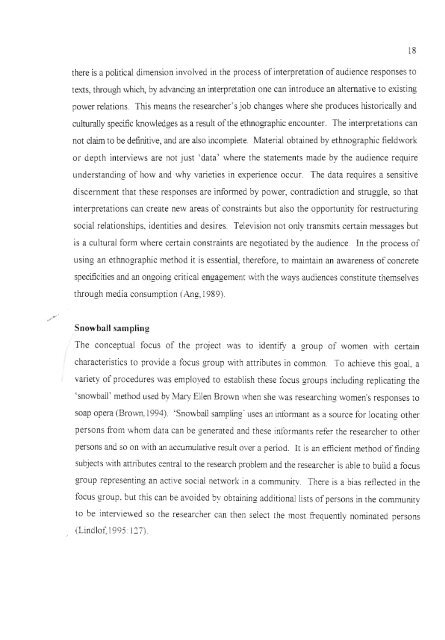View/Open - ResearchSpace
View/Open - ResearchSpace
View/Open - ResearchSpace
You also want an ePaper? Increase the reach of your titles
YUMPU automatically turns print PDFs into web optimized ePapers that Google loves.
there is a political dimension involved in the process of interpretation of audience responses to<br />
texts, through which, by advancing an interpretation one can introduce an alternative to existing<br />
power relations. This means the researcher's job changes where she produces historically and<br />
culturally specific knowledges as a result of the ethnographic encounter. The interpretations can<br />
not claim to be definitive, and are also incomplete. Material obtained by ethnographic fieldwork<br />
or depth interviews are not just 'data' where the statements made by the audience require<br />
understanding of how and why varieties in experience occur. The data requires a sensitive<br />
discernment that these responses are informed by power, contradiction and struggle, so that<br />
interpretations can create new areas of constraints but also the opportunity for restructuring<br />
social relationships, identities and desires. Television not only transmits certain messages but<br />
is a cultural form where certain constraints are negotiated by the audience. In the process of<br />
using an ethnographic method it is essential, therefore, to maintain an awareness of concrete<br />
specificities and an ongoing critical engagement with the ways audiences constitute themselves<br />
through media consumption (Ang, 1989).<br />
Snowball sampling<br />
The conceptual focus of the project was to identify a group of women with certain<br />
characteristics to provide a focus group with attributes in common. To achieve this goal, a<br />
variety of procedures was employed to establish these focus groups including replicating the<br />
'snowball' method used by Mary Ellen Brown when she was researching women's responses to<br />
soap opera (Brown, 1994). 'Snowball sampling' uses an informant as a source for locating other<br />
persons from whom data can be generated and these informants refer the researcher to other<br />
persons and so on with an accumulative result over a period. It is an efficient method of finding<br />
subjects with attributes central to the research problem and the researcher is able to build a focus<br />
group representing an active social network in a community. There is a bias reflected in the<br />
focus group, but this can be avoided by obtaining additional lists of persons in the community<br />
to be interviewed so the researcher can then select the most frequently nominated persons<br />
(Lindlof, 1995 : 127).<br />
18

















